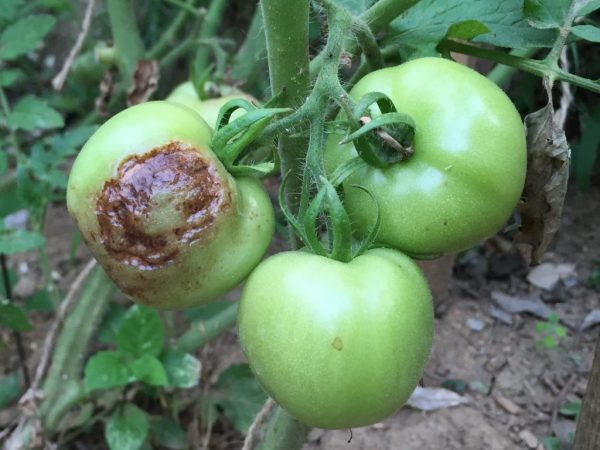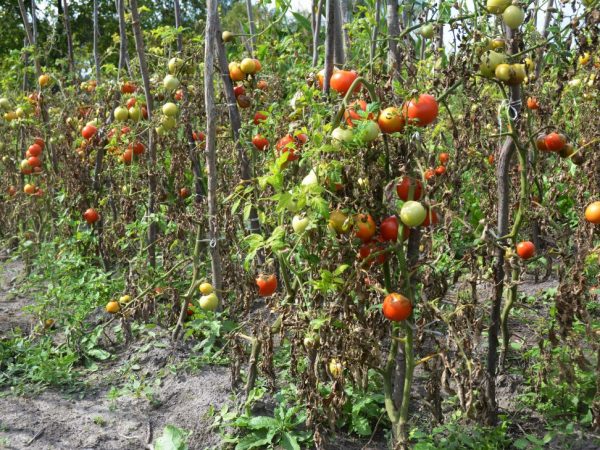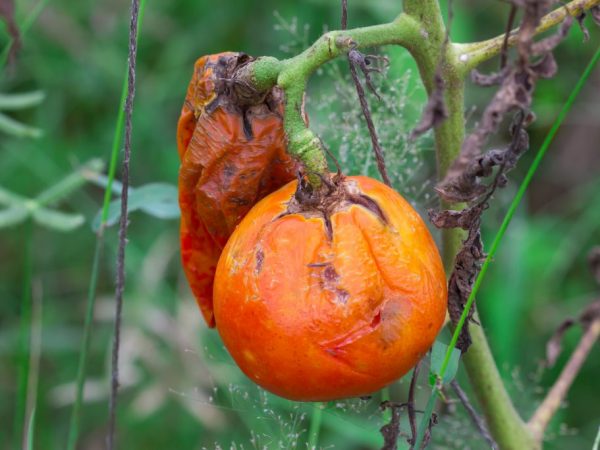Why tomatoes can rot
Many gardeners are racking their brains over the question of why tomatoes rot. Rot can ruin the entire crop. Tomatoes are quite whimsical plants that need an eye and an eye, otherwise they will quickly become infected with one of the many viral diseases. Very often, summer residents choose a tomato variety that is completely unsuitable for the climatic conditions of their region. The second and most important problem is improper care.

Causes of rotting tomatoes
Diseases causing rotting
Tomatoes rot under the influence of fungal spores, which can be carried by the wind or fall on the fruit from the ground. Spores of various fungi can be in the ground for a long time, and under favorable conditions they begin to actively multiply. Due to the multiplication of pathogenic microorganisms, protein biosynthesis is disrupted and fetal cells begin to decompose.
Most often, the appearance of rot is caused by such viral diseases:
- late blight;
- alternaria;
- top rot;
- necrosis;
- black rot.
Tomato late blight
The main danger that lies in wait for gardeners is late blight of tomatoes. The outbreak of viral infection occurs in the second half of summer, when temperature drops begin and a lot of precipitation falls. The phytophthora fungus can persist in the soil throughout the winter. First, the disease affects the lower tiers of the foliage, and then spreads to the fruits themselves, and it affects both green and ripe ones. The disease progresses very quickly and kills almost 70% of the plants.
It is not recommended to plant tomatoes in the immediate vicinity of potato beds, and in those places where potatoes grew last year. It is on root crops that late blight settles most often. Fungal spores cannot tolerate direct sunlight. With a lack of lighting and high humidity, spores begin to spread.
The main methods of fighting late blight is prevention and the correct choice of crops. In order not to face the disease, it is recommended to give preference to early ripening varieties of tomatoes. The further the tomatoes are planted from each other, the less likely the virus will spread. If the disease has just begun to manifest itself, it is recommended to remove the affected bushes and destroy them. For the treatment of healthy tomatoes for prevention, experienced gardeners are advised to use a solution of copper sulfate.
Top rot

It is easier to get rid of the problem in greenhouse conditions.
Tomatoes rot not only in the open field, but also in greenhouse conditions. Late blight can also affect greenhouse representatives, but it is much easier to cope with it in a greenhouse, because here the gardener can independently adjust the humidity and temperature. In greenhouse conditions, green tomatoes often rot on the bushes. The main reason is apical rot.
When ripe, on still green fruits, a brown spot appears, which increases as the fruit develops.The inside of a green tomato will be all rotten. Ultimately, the rot spreads to the stalks, and the vegetables fall off unripe. The disease is not viral. There can be several reasons for the appearance of rot:
- irregular watering;
- increased air temperature;
- increased acidity in the soil;
- lack of calcium;
- increased content of nitrogen in the soil.
Alternaria
The second ailment, from which green fruits rot, is Alternaria. Most often, it is found in southern regions with an arid climate or in greenhouses. The disease is viral. Alternaria fungus feels at ease at temperatures from 25 to 30 ℃ and humidity of about 70%. At the stalk, in the area of the butt, dark brown spots appear. The increased humidity contributes to the rapid formation of new spores, as a result of which fluff appears on the surface of the fruit.
In addition to the fruits, the leaves also rot. Ultimately, the disease leads to atrophy of the deciduous part and shedding of tomatoes. The method of struggle is the destruction of the affected bushes in the early stages, as well as the prevention of fungal infections.
Necrosis and black rot
Necrosis affects the stems. Black rings appear at the top of the green fruits near the stalk, and the inside turns into a cloudy liquid. At the slightest touch or a breath of wind, the fruits fall from the bushes. The deciduous part begins to wither from the top, without changing color. At a distance of about 20 cm from the root, wet dark spots are visible on the stem.
Another type of necrosis is necrotic streak or streak. It is a viral disease that damages bushes outdoors and in greenhouses. Stems and petioles are covered with brown-red stripes. Complete atrophy of the top of the plant is often observed. Brown spots also appear on the fruits, which subsequently crack and become a breeding ground for all kinds of mushrooms.
Black rot
Over time, the stems crack and mucus pours out of them. Black rot can appear on tomatoes grown in the open field and on those grown in the greenhouse. Initially, dark green spots appear on the leaves, which grow and become darker. The virus then spreads to the fetus.
Tomatoes are covered with shiny black raised spots. High humidity promotes accelerated reproduction and spread of fungal spores.
Lack and excess of vitamins

The health of the plant is also affected by the amount of vitamins.
In addition to viral diseases, tomatoes rot with vitamin deficiencies and an excess of vitamins. Basically, seedlings indicate a lack of minerals.
- Lack of calcium leads to the appearance of young domed leaves with a tuberous structure, the stems break easily, the root partially atrophies.
- Young leaves shriveled from below indicate a lack of potassium. Sometimes a marginal burn is noticeable.
- Root decay, sluggish leaves signal a lack of copper.
- When a plant changes its color from green to purple, it is a signal that it lacks fluoride. Fluorine is involved in the construction and synthesis of cells. Most of all, tomatoes need it after the first pick, therefore, the phenomenon of a lack of substance is mainly observed during this period.
- Chlorine deficiency is manifested by yellowing and wilting of the deciduous part. For optimal plant development and growth, the soil must contain 0.02% chlorine.
- Lack of nitrogen is manifested in the pallor of the foliage. Yellowness is more noticeable on the basal leaves, the stems become thinner and tough, growth slows down.
- The leaves turn yellow on the outside, but the veins remain green - this indicates a lack of iron.
An excess of nutrients leads to root burns or rotting. With both a deficiency and an overabundance of minerals, the root system stops distributing nutrients throughout the plant.When the soil is oversaturated with minerals, the plant simply cannot absorb so many nutrients, so the deciduous part begins to wither and curl, and the fruits themselves rot.
Improper care
Tomatoes are quite whimsical plants and require constant attention. Fruit decay is observed even in greenhouse conditions with a lack or excess of moisture. The tips of the tomatoes begin to turn black if the gardener does not follow the watering regime. For example, he left for a few days, and then flooded the whole garden.
First, dark spots appear on the bush, which grow as the fruit itself grows. The core of the tomatoes hardens and becomes firm. If most of the tomatoes are on wet soil, dry rot will turn into wet rot. Heat and high humidity stimulate the spread of apical rot.
The blackening of the integument of tomatoes occurs due to the fact that moisture does not reach them, but remains in the deciduous part. In such conditions, the fruit ripens very quickly. If the irrigation regime is not observed at the pollination stage, the flowers fall off the branches and the bush may not bear fruit at all.
Preventive measures
Tomatoes rotten from the inside are the main problem for many gardeners. If the tomatoes are rotten from the bottom, this may be the first symptom of a viral disease called phytosporosis, which progresses in the middle of summer, if conditions are favorable. The virus quickly spreads throughout the bush, and the spores of the fungus are carried downwind to neighboring bushes. In addition to viral diseases, the cause can be a banal lack or excess of moisture and vitamins.
Today there are many methods to get rid of fungal diseases using chemicals, but it is better to start prevention from the moment the seed is prepared. All seeds, even those bought in the store, should be pickled by pre-soaking them in a solution of potassium permanganate. In order not to have problems with a lack of minerals, after picking, you need to apply fertilizers to the soil several times to ensure the full development of the root system and the ground part.
It is important to remember that the fungus settles in the root, and then spreads throughout the plant, so it will not be superfluous to examine the rhizomes of all shoots during transplantation and immediately remove the damaged ones. If you notice that tomato leaves are rotting at an early stage of growth, it is better to get rid of damaged sprouts right away, and treat the rest with a special compound or water with a slightly pink solution of manganese. Watering regime is the most important part of tomato care. Only soil should be spilled, make sure that splashes do not fall on the deciduous part. If the weather is humid, it is recommended to thin the foliage of the lower part.
Fertilizers should be applied on time and in a certain amount. An excess of them can also cause rotting vegetables. As a prevention of late blight, it is recommended to choose early ripe or purple varieties of tomatoes that are resistant to fungal diseases.


